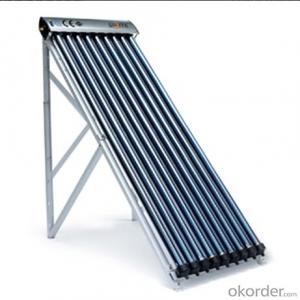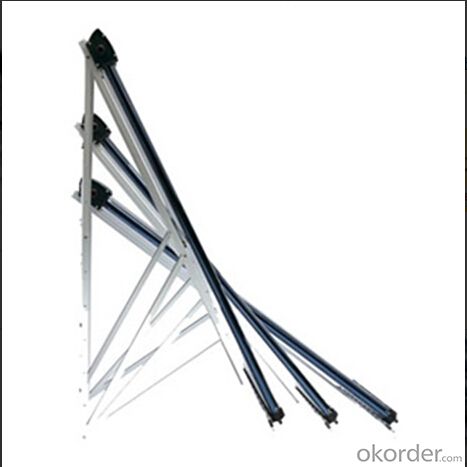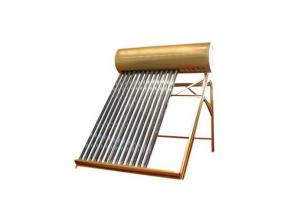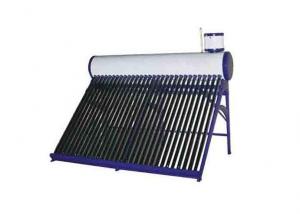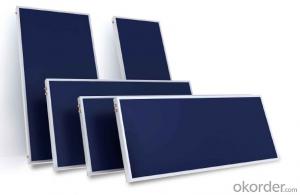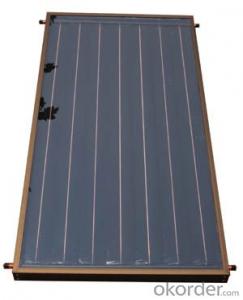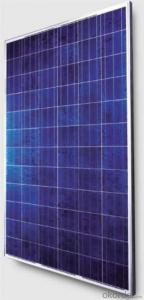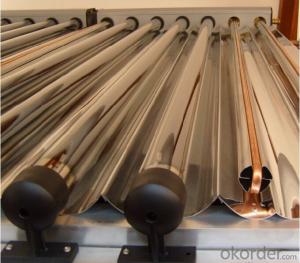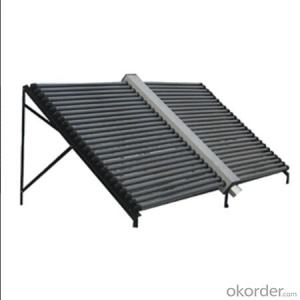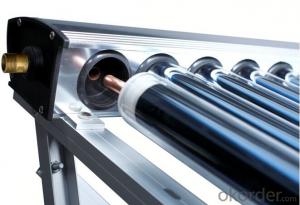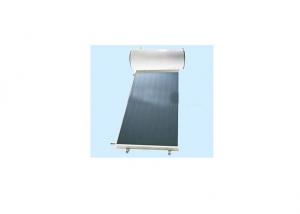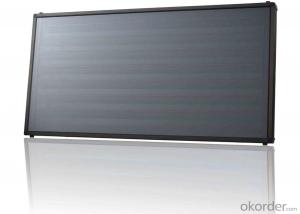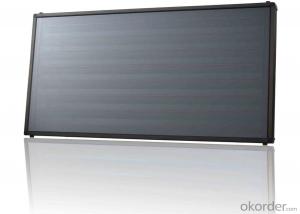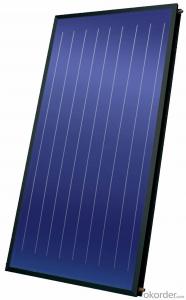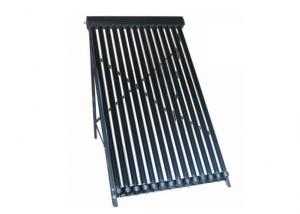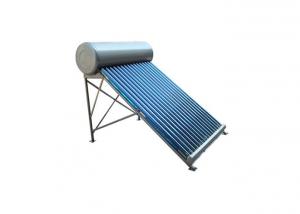Focus Type Solar Collector with Adjustable Frame Model SC-HAJ
- Loading Port:
- Shanghai
- Payment Terms:
- TT OR LC
- Min Order Qty:
- 1 set
- Supply Capability:
- 2500 set/month
OKorder Service Pledge
OKorder Financial Service
You Might Also Like
1. Structure of Solar Collecter with Adjustable Frame Model SC-HAJ
Solar collector of this series are made of aluminum alloy for frame, rock wool for the installation, tri-element vacuum glass tube and antifreeze heat pipe. It can work under the temperature -40℃-300℃. The components are following as shown with graphic:
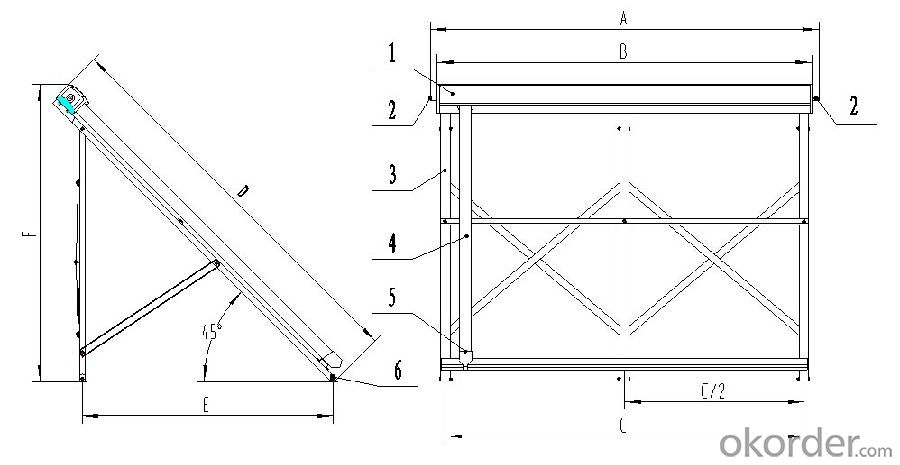
1.Solar collector manifold :1.1 Manifold shell; 1.2 Thermal insulation; 1.3 Inner tank;
2.Solar collector connector
3,Solar collector bracket
4.All glass vacuum tube: 4.1 Vacuum tube; 4.2 Aluminum fin; 4.3 Heat pipe
5.Tube holder
6.Wind fee
2. Main Features of Solar Collecter with Adjustable Frame Model SC-HAJ
. The Frame degrees can be adjusted to fit any latitude.
. The manifold can be moved to left or right side to fit the different kinds roof styles.
. The frame material can use the Aluminum alloy from 2.0-3.0mm.
3. Solar Collecter with Adjustable Frame Model SC-HAJ Images
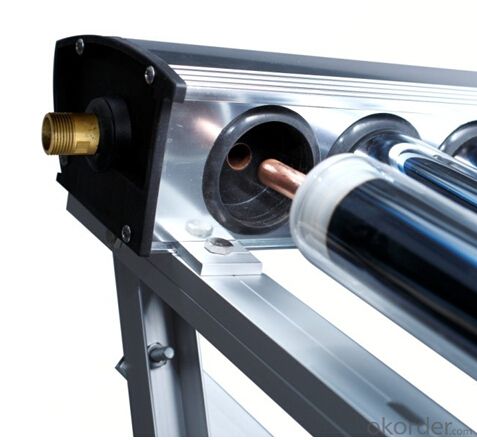
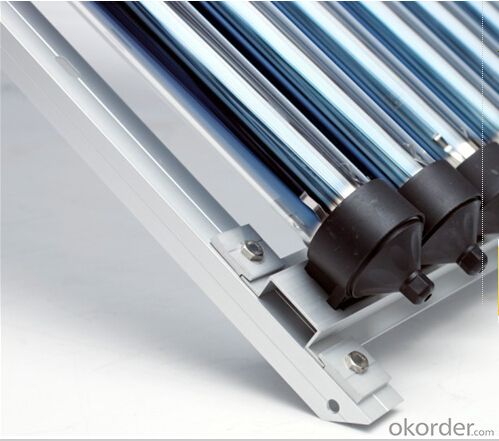
4. Solar Collecter with Adjustable Frame Model SC-HAJ Specifications
Model | SC-HAJ-10 | SC-HAJ-15 | SC-HAJ-18 | SC-HJA-20 | SC-HAJ-24 | SC-HA-25J | SC-HAJ-30 |
SC-H1-10 | SC-H1-15 | SC-H1-18 | SC-H1-20 | SC-H1-24 | SC-H1-25 | SC-H1-30 | |
Vacuum tube quantity(pcs) | 10 | 15 | 18 | 20 | 24 | 25 | 30 |
Tube spacing (㎜) | 75 | ||||||
Vacuum tube diameter/length (㎜) | φ58/1700 | ||||||
Vacuum tube material | high borosilicate glass 3.3 | ||||||
Vacuum tube inner/outer pipe wall thickness (㎜) | 1.6/1.8 | ||||||
Heat pipe condensing end diameter/length (㎜) | φ14/1750 | ||||||
heat pipe material/wall thickness (㎜) | Copper tp2/0.6 | ||||||
inner tank diameter/wall thickness (㎜) | φ35/1.0 | ||||||
connector size | φ22 or 3/4″ | ||||||
collector insulation material/thickness (㎜) | Rock wool/40 | ||||||
solar collector rated pressure (MPa) | 0.6 | ||||||
collector operating temperature ℃ | <100 | ||||||
collector volume (L) | 0.69 | 0.98 | 1.15 | 1.27 | 1.50 | 1.56 | 1.85 |
collector aperture area (㎡) | 1.0 | 1.5 | 1.8 | 2.0 | 2.4 | 2.5 | 3.0 |
collector total area (㎡) | 1.56 | 2.30 | 2.74 | 3.04 | 3.63 | 3.77 | 4.51 |
referral traffic (L/min) | 0.75 | 1.13 | 1.35 | 1.50 | 1.81 | 1.88 | 2.26 |
intensity pressure (Pa) | 23.2 | 59.2 | 90.6 | 116.7 | 181.7 | 200.2 | 314.0 |
intercept efficient η0 | 0.744 | 0.744 | 0.744 | 0.744 | 0.744 | 0.744 | 0.744 |
heat loss coefficient a | 2.09 | 2.09 | 2.09 | 2.09 | 2.09 | 2.09 | 2.09 |
collector power (W)1000W/㎡ irradiation | 620 | 870 | 1047 | 1165 | 1401 | 1457 | 1748 |
collector net weight (kg) | 38.25 | 50.75 | 59.75 | 64.75 | 79.00 | 83.35 | 98.70 |
a (㎜) | 895 | 1270 | 1495 | 1645 | 1945 | 2020 | 1395 |
b (㎜) | 800 | 1175 | 1400 | 1550 | 1850 | 1925 | 2300 |
c (㎜) | 725 | 1100 | 1325 | 1475 | 1775 | 1850 | 2225 |
c/2 (㎜) | —— | —— | —— | —— | 887.5 | 925 | 1112.5 |
d (㎜) | 1980 | 1980 | 1980 | 1980 | 1980 | 1980 | 1980 |
e (㎜) | 1240 | 1240 | 1240 | 1240 | 1240 | 1240 | 1240 |
f (㎜) | 1470 | 1470 | 1470 | 1470 | 1470 | 1470 | 1470 |
5. FAQ
1. What happens if one of the solar tubes is broken?
Firstly, tubes are very strong and not easily broken, but if the worst should happen, solar tubes can be replaced very easily. They are inexpensive and available. The solar collectors can operate with several broken tubes, but the efficiency will be reduced, so it is recommended that broken tubes be replaced immediately.
2. Can the solar collectors be mounted on a flat surface?
Yes they may be mounted on a flat roof or on the ground by using a stainless steel Flat Roof Frame. The collector should be installed at a minimum of 20o angle to ensure optimal operation of the heat pipe.
3. Will the solar collector be a fire hazard during hot, dry weather?
No. The solar collector's components are all high temperature rated and non-flammable, so even during strong sunlight with the circulation pump turned off (stagnation), the system will not catch alight or give off any sparks. The majority of the solar collector's components are stainless steel, aluminium, glass or glass wool. The manifold outlet should be fitted with a temperature relief valve, which will prevent the manifold temperature from exceeding 99oC / 212oF.
- Q: How much maintenance do solar collectors require?
- Solar collectors require minimal maintenance. They are designed to be durable and long-lasting, with few moving parts. Regular cleaning of the panels to remove dust and debris is recommended, but other than that, occasional inspections to check for any issues or malfunctions are typically sufficient. Overall, solar collectors are a low-maintenance solution for harnessing solar energy.
- Q: How much electricity can a solar collector generate?
- The amount of electricity a solar collector can generate depends on various factors such as its size, efficiency, location, and weather conditions. On average, a standard solar collector can generate enough electricity to power a household or small business. However, larger and more efficient solar collectors can generate even more electricity, potentially supplying excess energy to the grid.
- Q: Can solar collectors be used for drying household appliances?
- No, solar collectors cannot be used for drying household appliances. Solar collectors are designed to capture and convert sunlight into heat energy, which can then be used for heating water or generating electricity. They are not suitable for drying household appliances as the heat generated by solar collectors is typically not high enough to effectively dry appliances. Household appliances such as clothes dryers require a much higher temperature and specific airflow to efficiently dry clothes or other items. Therefore, alternative methods such as air drying or using specialized drying appliances would be more suitable for drying household appliances.
- Q: Can solar collectors be used for heating commercial buildings in winter?
- Heating commercial buildings in winter using solar collectors is possible. Solar collectors, also called solar thermal systems, utilize the sun's energy to heat water or air, which can then circulate in the building to provide heat. Although solar collectors are commonly associated with producing hot water, they can also be used for space heating. Even in colder temperatures, solar collectors can effectively capture solar energy during winter. The key is to design and size the system appropriately to meet the heating demands of the commercial building. Factors such as the building's size, insulation levels, and heating requirements must be taken into account. To maximize the efficiency of solar collectors during winter, certain design considerations can be made. These include positioning the collectors at an optimal angle to capture the most sunlight, using high-performance glazing to minimize heat losses, and incorporating thermal storage systems to store excess heat for use during periods of low solar radiation. In regions with limited sunlight during winter, it may be necessary to supplement solar heating with alternative sources like natural gas, electric heating, or heat pumps. These backup systems can provide additional heating capacity when solar energy is insufficient to meet the building's needs. To sum up, solar collectors can be used to heat commercial buildings in winter. However, it is important to consider proper system design, sizing, and potential backup heating sources to ensure efficient and reliable heating throughout the colder months.
- Q: Can solar collectors be used for heating electronics manufacturing plants?
- Yes, solar collectors can be used for heating electronics manufacturing plants. Solar thermal systems can be installed to capture and convert solar energy into heat, which can then be utilized for various heating applications including heating the manufacturing plants. This can help reduce reliance on conventional heating sources and lower energy costs while also promoting environmental sustainability.
- Q: How do solar collectors compare to traditional heating methods in terms of efficiency?
- Solar collectors are generally more efficient than traditional heating methods because they harness the energy from the sun, which is a renewable source, to generate heat. Traditional heating methods, on the other hand, often rely on non-renewable resources like fossil fuels. Solar collectors have the potential to provide a higher energy output per unit of input, making them a more efficient and sustainable option for heating.
- Q: Can solar collectors be used for heating sports arenas?
- Yes, solar collectors can be used for heating sports arenas. By harnessing the sun's energy, solar collectors can generate heat which can be utilized for heating purposes, including large spaces like sports arenas. This environmentally-friendly alternative helps reduce reliance on fossil fuels and lowers energy costs for heating such facilities.
- Q: Can solar collectors be used for space heating in colder regions?
- Yes, solar collectors can be used for space heating in colder regions. While solar energy is less abundant in colder regions due to shorter daylight hours and lower solar radiation, properly designed solar collectors can still harness enough energy to provide heat for space heating. Additionally, using efficient energy storage systems and integrating solar collectors with existing heating systems can help ensure reliable heating even in colder climates.
- Q: Can solar collectors be used for heating in desert regions?
- Solar heating is a viable option for heating in desert regions. The abundance of sunlight in these areas makes them an ideal location for solar collectors. Solar thermal systems and solar water heaters are examples of collectors that can convert sunlight into thermal energy for heating purposes. Deserts are characterized by high levels of solar radiation and clear skies, making them perfect for solar heating systems. The intense sunlight allows for efficient collection of solar energy, and the high temperatures make it easier to achieve desired heating levels. Solar heating systems can be used for various applications in desert regions, including space heating, water heating, and industrial processes. They can be integrated into different types of buildings and even used to heat swimming pools, which are popular in desert regions. In addition to their practicality, solar heating systems offer a range of benefits in desert regions. They are environmentally friendly, reducing reliance on fossil fuels. They also have low operational costs, as they require minimal maintenance. Furthermore, solar heating systems can help reduce energy bills in desert regions, where cooling costs can be high. To sum up, solar collectors are a reliable and sustainable heating solution for desert regions. Their ability to harness sunlight and generate thermal energy makes them a practical and cost-effective option for various heating applications in these areas.
- Q: Can solar collectors be used for heating sidewalks?
- Yes, solar collectors can be used for heating sidewalks through a system called solar thermal heating. This involves capturing solar energy through collectors and transferring it to a fluid, which is then circulated through pipes buried beneath the sidewalks to provide heating.
Send your message to us
Focus Type Solar Collector with Adjustable Frame Model SC-HAJ
- Loading Port:
- Shanghai
- Payment Terms:
- TT OR LC
- Min Order Qty:
- 1 set
- Supply Capability:
- 2500 set/month
OKorder Service Pledge
OKorder Financial Service
Similar products
Hot products
Hot Searches
